#homebrew deity
Text
I MADE A GUY!
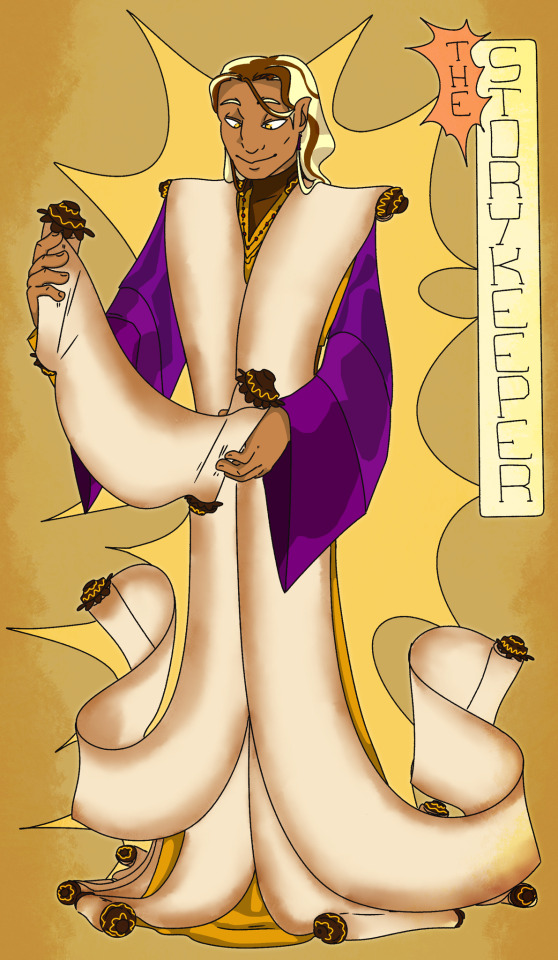
Introducing the Storykeeper! An mischievous deity who loves nothing more than a good book (He may or may not find morally gray adventurers to be those stories).
#this was a commission from my DM#he’s the patron deity of my character Elleathe#very slay#we get to fight him this week#it’s gonna take like two sessions#phrart#dnd#it’ll be great#art#character design#phrog croaks#homebrew deity#the storykeeper#dnd gods
27 notes
·
View notes
Text

first art of 2024 is of Agra! she's looking pretty sweet in this picture (she's got a nasty temper to be sure)
#oc#art#digital art#dungeons and dragons#hexian/xithian/almara#original character#homebrew deity#the vibes are giving steven universe meets barbie
9 notes
·
View notes
Text
"What is entropy but chaos purified? Chaos in harmony"
My warforged cleric, Alo (E109-5)
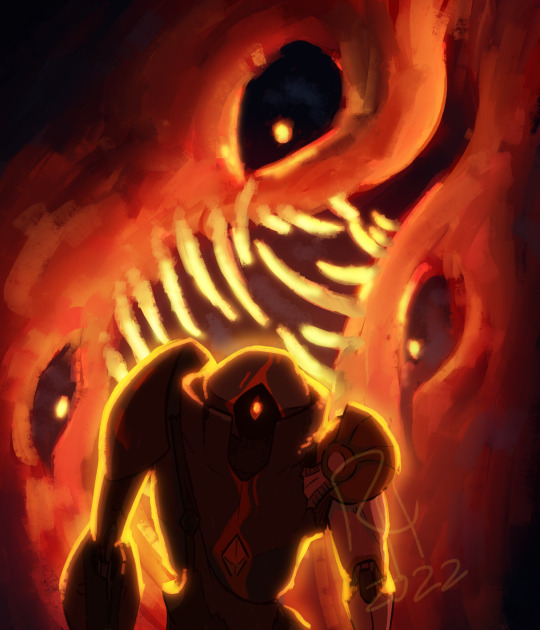
#rynooc#dnd#dnd character#drawing#art#dnd 5e homebrew#warforged#trickery cleric#dnd cleric#entropy#robot#dnd homebrew#homebrew deity
25 notes
·
View notes
Text

mhh Kára thoughts... She and her wife broke up
#art#digital art#my art#dnd#dungeons and dragons#oc#dnd oc#dnd npc#water genasi#genasi#noluna campaign#dnd art#goddess#deity#water goddess#homebrew deity
50 notes
·
View notes
Text

my special, amoral, and eldritch boy
#my art#my ocs#dungeons and dragons#dnd#dnd homebrew#garden is the patron of one of the pcs im dming! what a nice guy.#the flower hes holding is a datura#the flowers growing on him have no specific type and theyre not meant to be quote unquote real#some of my players follow me on here but they never check Tumblr so hopefully this will fly under their noses lawl#dnd deity#dnd warlock#great old one#great old one warlock
32 notes
·
View notes
Photo
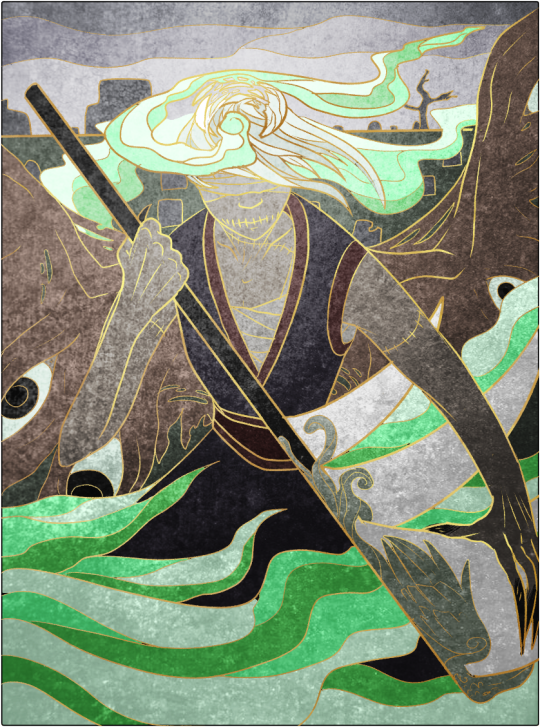
Evermore, the God of Death and the Afterlife.
Often considered the sibling of Ciurte, the God of Judgement and Balance, Evermore is a much more distant and enigmatic being. Only really formally seen as a member of the Common Pantheon, Evermore is said to appear at the end of everyone’s life to reap their soul and ferry them to the afterlife - whatever that may be. They are not known to be a being that can be bargained with, and though tales may try to spin otherwise, many do not believe there has ever been a genuine event in which one has tried to fight Evermore and won.
To most, Evermore acts rather robotically - they have a goal, a soul to reap, and all else is meaningless. The result will be the same, and all words and belief otherwise is lost on them. For this reason, worship of them can be rather uncommon - most believe there is no purpose into singing praise to the god of death or anything like that, as in the end they will take your soul the same way as anyone else’s. Those who do worship them consider it a simple thank you to a job unappreciated - Evermore will take all the same, without hesitation or difference, and none can get out of it or will be left behind.
While Evermore is not known for showing any personality, let alone speaking, some priests and beings claim that Evermore has contacted them in some fashion. Many priests imply that it is not words, but more of a simple understanding of the god’s will and desires (which the concept in of itself is doubtable to many). Other deities closely tied with death and the afterlife, such as Tahtvokoolah and Bayu, have also been known to speak about Evermore as though they are more then a automated husk.
#the scythe is 100% decorative / symbolic#grim reaper#undead#god#deity#homebrew#dnd#dungeons and dragons#ttrpg#tabletop#worldbuilding#Evermore#Now with... honestly maybe as edgy as they ever were#just with 100% more Nonbinary and 100% less Sleeves
67 notes
·
View notes
Text
The Nightingale; Existentialism
Old friend,
we meet again
Been a long time coming
After all these years
The Caller sings my name
Like the song of a
Lone mournful bird
Its melody,
bittersweet
But, when he calls
You have to heed
I’ve never seen him before
However…
He knows my name
And I know him too
He’s comparable
To waking in the morning
For no apparent reason
Early enough to watch the sun rise
Won’t be long now
Till it sets
You knew me well
And I’ve always had your name
Somewhere hidden away
We don’t like to think about
Things like that
Fragile beings that we are
Life in its infinite finitude
Do we treasure it enough?
Will the sums of our memories
Hold up against the vast future
As it continues on without us
Unhalting in its venture around the sun
Will my name be uttered in conversation
By people for years to come
Or will it cease to be as I have?
Who will remember me?
#poefeathyr#aesthetic#beautiful#the nightingale#unrelated I did make the nightingale deity on the homebrew dnd wiki#I guess it is related but it's outdated now#maybe I'll update it soon to match my fantasy world#but he's not really a god anymore he's more like an angel or a demi-god now#poetic#poem#existentialism
10 notes
·
View notes
Text
blood for the blood god but not blood god in the traditional sense of murder and sacrifice and war
blood in the way of everyday pains
a blood god who is the deity of childbirth, of womanhood and first bloods, whose name is invoked when one goes into labor or surgery or elsewhere where blood will be spilt in the holiest of ways; for the sake of life rather than death
a blood god who is dutifully worshiped and respected as a head of a pantheon rather than a cast-out evil, a mother or matron
one who, while normally reserved for the more domestic bloodlettings, is called upon in the name of protection -- to protect one's bloodkin in battle, to see them safe to the other side
#rook rambles#rook writes#been chanting /blood for the blood god/ in my head for the past few days#and then thought about it for a bit too much#anyways this seemed like a cool concept for a homebrew dnd deity or something like that
12 notes
·
View notes
Text
So. Out of curiosity, given recent events, I was looking at Pathfinder 2e, just to see what it felt like. And, being me, I decided to do this by seeing how easy/difficult it would be to port my homebrew deities over to it. And the results were … interesting.
In that it is not necessarily easy to port deities over, but for a rather cool reason and in a cool way. Apparently, if I am understanding things correctly, your deity is functionally your subclass as a cleric in PF2e? As in, you get a couple of spells from your domain, sure, but you get more spells, an ability increase, a skill, a weapon, and your Divine Font all from your deity. You also need to match your deity to your alignment, and your deity gives you edicts to try and follow and anathemas to avoid if you don’t want to face consequences. Your deity is, essentially, your subclass.
(I’m not ignoring doctrines, I’m just mentally thinking of them more like warlock pact boons? Actually, PF2e clerics are reminding me of 5e warlocks in a couple of ways, really)
It's actually … Honestly, I find that really cool? From a worldbuilding perspective. Now, I can see from a player POV how it might feel quite restrictive, particularly the alignment, edicts and anathemas, but from a story-expressed-in-mechanics POV … It always slightly bugs me in DnD5e that clerics of completely different gods who happen to share a domain will be mechanically identical. You can have, for a random example, a Trickery cleric of Asmodeus and a trickery cleric of Garl Glittergold, and they’ll play the exact same way (mechanically, not counting RP). Your deity, to an extent, is kind of a cosmetic choice beyond domain. But in Pathfinder, your deity is distinctly more crunchy and involved, and I do kinda love it.
It does make porting homebrew deities from DnD5e to PF2e a bit more involved. I am going to work on it, just to see what it’s like, but already I’m having to think about a lot more than the alignment and domains of 5e. Though that is … in one sense it’s fun as a worldbuilder, because a lot more of the deity’s ideals and values and pet peeves are represented mechanically. It’s cool. Working out their domains, their edicts, their anathemas, their boons, their abilities/skill, their spells …
As an extension of this, can I say, there’s some really gnarly spells in PF2e. I’ve no idea if they’re good or not, but for ideas alone there’s some spectacular stuff. For Nalashtar, the plague goddess, for example, I was browsing both Blister and Grisly Growths as potential options (I think Grisly Growths might be the one). Absolutely disgusting, but thematically amazing.
The only downside is, again if I’m reading this correctly, the spells given to deities need to not be on the divine spell list, because deity spells don’t work like DnD5e domain spells, where clerics get them as extra prepared spells a day, and instead are more like warlock patron spells, where they’re options that the cleric can prepare, but they don’t get them always prepared for free. So if a deity’s spell is on the divine spell list, it functionally gives the cleric absolutely nothing extra, since they already had that spell as an option to prepare.
This is a bummer, just from a thematic standpoint, because I read the spell Quick Sort and instantly wanted to give it to Alatee. Is it useful? Not a clue. But it’s bang on for theme. And, yes, she has it anyway, in the general sense that her clerics can use it, but it would have been so good to have it front and centre in her bio to remind people. Oh well. If I make a cleric of Alatee, I’ll know it’s there.
This is definitely turning out to be an interesting exercise, whatever else. Heh.
(Sidenote: I’m getting my PF2e info from the Archives of Nethys site)
#d&d#pathfinder#homebrew#deities#homebrew deities#converting dnd5e to pf2e#it's definitely interesting!#pf2e
99 notes
·
View notes
Text
shoutout to all the dungeon masters getting new character ideas from players with backstories that involve the forgotten realms pantheon (shar & selune especially) after the cultural wave of BG3 - even though your homebrew worlds uses a different pantheon of gods
#its me shoutout to me#but shout out to all of u homebrew dms too#i dont mind it as much. bc i can just 'mod' them into my game as minor deities but yeah#someone pls make a hit videogame that uses the dawn war pantheon (or better yet. the exandria pantheon)#so that i can have something that CATERS SPECIFICALLY TO ME (dont attack me) that i can show to my players.#KLJHFSDKLFJHASDKL#dnd#dungeons and dragons#bg3#baldurs gate 3#homebrew
8 notes
·
View notes
Text

Inktober Day 1: Dream
Come again seeking answers in the realm of dreams?
#myart#art#dnd#coranima#deities#homebrew#the island of six eyes#dnd oc#oc#like sisyphus I once more embark on an art prompt month#inktober#inktober 2023#dream#cats
13 notes
·
View notes
Note
A god of fire and void, meteor king of conquest, plumiting downwards to its next victim (bonus points if its a blue like a commet)

Deity: Mnyull, the Revelation Tyrant
Fasinating stuff my friend, my latest translation of old imperial accounts reveal a previously unknown confession from the rogue general Paldermot. As you well know, current historical narratives have the general sacking the capital city in a failed attempt to seize power from the Tribunes, but if this text is to be believed the Tribunes captured Paldermot and dispersed his rebel legion before he ever entered the city. It goes on to say, in a transcription of Paldermot's own words that he had "Followed a star" to the "seat of a new imperium", and claimed that the star had promised great allies to aid him in his conquest. The text is unquestionably authentic , but it throws our entire understanding of events into question; If Paldermot was captured in the midst of his rebellion, who or what destroyed the capital and turned the surrounding countryside into a crater?
Setup: Hurdling across the void of the astral sea, the meteoric god Mnyull brings ruin wherever he goes, the embodiment of unrelenting invasion at the hands of an inexorable foe. Unlike other gods which present themselves in abstract forms felt across the multiverse Mnyull prefers to exist as an incarnated singular being, a towering construct built around the mummified yet undying body of his current mortal avatar.
This living reliquary leads an army of crusading zealots scattered throughout the multiverse known as the starry horde, followers and adherents of its former vessels who believe that by serving the Revelation Tyrant, they continue the legacy of their particular heaven-chosen liege. It is important to note then that Mnyull and his followers do not adhere to any one ideology as they hold the act of conquest itself sacred, whatever form that conquest takes. Like a shooting star the tyrant god is constantly on the move, dragging his followers into one conflict after another before retiring to a palatial demiplane of rock and ice for decades or centuries at a time to rule those realms where his cult has taken hold.
It is for this reason that some theologians have considered classifying Mnyull as an outergod, those divine beings considered actively hostile to the stability of realities they interact with. Debate rages in those lofty circles however as the hostility the Revelation Tyrant represents usually takes the form of “ Invade them with an alien army before or after hitting their world with a big rock or series of big rocks”. While the scholar dither, Mnyull bides his time, growing ever closer to some innocent world that has no idea of the disaster that is about to strike it.
Hooks:
The Party’s homeland is struck by the invasion force of a kingdom that fell to Mnyull’s influence generations ago. While more traditional warfare occupies the early adventures of the campaign, they begin to uncover hints of lore about their enemy’s newly arisen (and apparently immortal) theocratic leader along with the strange monument she’s building. Just as it seems they might have an upper hand against the invaders, their enemies deploy new and terrifying weapons and otherworldy allies, sourced from the portal they’ve just finished building.
Sometimes Mnyull decides to feed his urge for conquest by invading a random plane, riding a chunk of astral rock through its firmament and establishing a kingdom wherever he lands. The Revelation Tyrant is not a creature of foresight however, and on his most recent outing ended up impacting into one of that plane’s moons. Refusing to give up he’s carved out a realm among the strange creatures that live among the palid rocks of that blasted planetoid, and now sets his sites upon the verdant world below.
While enjoying a trip to the local archives and observatory, the party are interrupted by agents of the starry horde, looking to plunder the vaults looking for information regarding great weapons created to break worlds known only as “The Anvils”. Predating even the Revelation Tyrant’s earliest memory, Mnyull once used his divine will to steer these ancient tools towards ever more destructive ends, until a coalition of forgotten heroes toppled him from his throne for fear he would turn the weapons upon them.
Background: None can say where Mnyull first emerged, but planear scholars have charted the tyrant god’s course across world after world and have noticed a self perpetuating cycle: Some would be warlord sees a silvery star or comet and it awakens in them a desire for conquest, though more often than not they would have began life as someone who already exerted authority over others. Strange powers and allies allow these conquerors to amass a fanatical following and become a true threat to the powers of that age, leading to a climatic confrontation where they are either killed, or rise to claim a throne and immortality. A harsh and “glorious” reign begins, and the ruler demands the construction of great monuments which will serve as portals in Mnyull’s next conquest. Should the Revelation Tyrant lack a body at the moment, one of these ascendant rulers becomes his next vessel, feverishly instructing their underlings how thier body is to be mutilated and interred in preparation for their apotheosis. When the reliquary is built around them, Mnyull’s silver-blue light strikes them full force, their soul igniting to serve as the perpetual fuel for the tyrant god’s engine.
Titles: The Tyrant’s Star, All-conquering Meteor King, Khan of the Starry Horde, Imperitor-Celestium. Along with any other titles inherited from his innumerable vessels.
Signs: A silver-blue comet or star blazing in the sky, Meteor Showers that produce snowfall without clouds, Ecstatic Visions of victory and conquest, weaponry shining silver
Symbols: The arc of a Comet above a Crown, Chariot, or Other sign of Lordship.
Followers: Warmongers of all kinds, be they authoritarians or Rebels. Mnyull has also accumulated followers across the astral sea, so numerous entities which range the cosmos looking for battle are drawn into his service voluntarily or by indoctrination.
Art
#deity#divinity#outergod#outer spheres#divinity: stars#divinity: war#The Palace Moon#high level#paladin#fighter#Cleric#warfare#dnd#dungeons and dragons#adventure#5e homebrew#homebrew adventure
260 notes
·
View notes
Text
Y'know, I feel like spiders could work really well as a symbol of creativity.
#I'm not about to complain about Lolth because I mean she works#but just imagine getting a more neutral spider deity that was like... really really passionate about creativity#I guess one could argue that Lolth's focus on cruelty IS also creative but it's also really not what I have in mind#I've been thinking about homebrewing a new drow deity for a few years that is also associated with spiders but without#all of Lolth's shittiness#maybe I'll actually start working on that again next year
10 notes
·
View notes
Text

A corrupt "Angel" birthed by Tiamat; her most prized prince & first born.
A Deity of Deals, Power & Punishment (Lawful Evil)
Also known as "The Burning Prince". A child of Tiamat, a deity that was turned into a Fiend during the Divergence. Now the Prince of the Hells, Patron of Warlocks, and Bringer of Flame.
Typically depicted as a humanoid figure with large draconic wings, four arms each holding weapons, & two dragon heads with their horns tangled into the twisted remains of a halo. He is also often depicted with his entire body engulfed in flames.
#artists on tumblr#digital art#fantasy art#furry art#furry#dnd art#dnd#dnd character#dnd oc#dnd5e#dnd homebrew#dnd au#dnd oc art#fantasy illustration#fantasy character#dungeons and dragons art#dragon#dragon art#deity#oc design
5 notes
·
View notes
Text
if u are one of my dnd players look away NOW. or ill explode you.
anyway. now they're gone. some sibling deities for my upcoming campaign!!
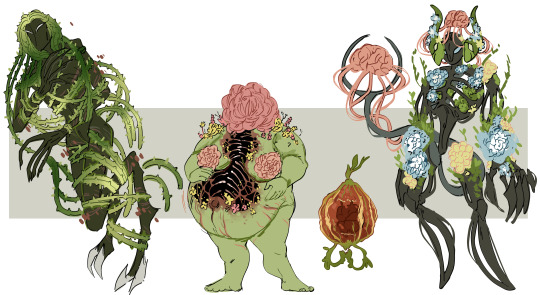

left to right is oldest to youngest
#my ocs#my art#dungeons and dragons#dnd#dnd oc#dnd character#dnd god#dnd deity#dnd homebrew#dungeons and dragons homebrew#cw pregnancy#cw gore#lemme know if you'd like any other content warnings#bc Bloom is disGUSTANNNGGG
19 notes
·
View notes
Photo

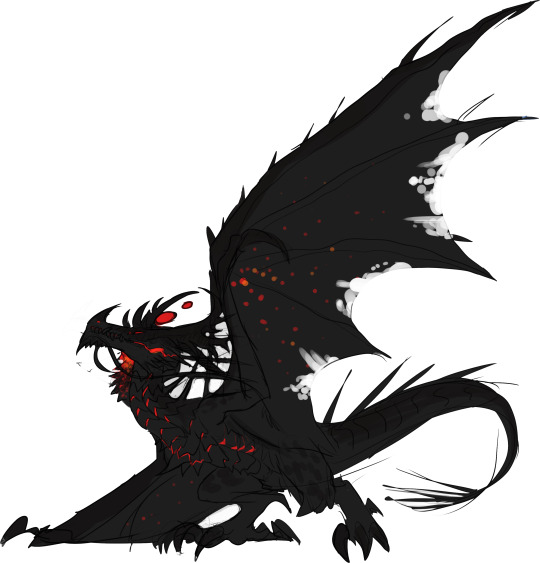

Maholdymyndr is the first born son of the World Mother, Bukrkry, and the Drylvuian God of Destruction, Darkness, Fire, and Anger.
Maholdymyndr, though absent in the last few centuries of the world, has been eternal dark shadow over the heads of the people of Aanrah. Known as a brutal, violent, and ever-hungry monster, Maholdymyndr is long known for attacking both divine and mortals relentlessly. Already born a mighty power, Maholdymyndr has climbed in strength after slaying two of his brothers - Deiahdrahl and Droontastah.
Maholdymyndr seeks to slay and consume his remaining two brothers, Brástaath and Jodiirook, so he might become what he believes to be ‘whole’ as their mother was, and create the world anew in his image. To the relief of many, both he and his remaining brothers disappeared without a trace with the decline of dragons, and many hopes that perhaps he may never return.
(Cont. under the cut)
Unfortunately, Maholdymyndr is plenty alive - as are his siblings. Asleep within Aanrah’s tallest mountain, Gezralahdnat, Maholdymyndr bides his time for another age, hoping for one where the mortals have forgotten the threat of dragons and grown soft again. He knows his brothers have hidden themselves for similar reasons - the era of Magic made mortals able to stand toe-to-toe with the once more dominant dragons, and between a sudden interest in systematically slaying dragons and dragon’s general propensity to interbreed with other species, pure blooded dragons were almost extinct.
Maholdymyndr plans for a day when they will rise again and, maybe for a short time, he may make alliance with his brothers to secure the survival of their kind - and if he cannot, then he will simply slay them then and there and remake the world anew.
Maholdymyndr is considered the biggest threat to the three chief gods - Yalidil Rana, Cirute, and Zwinwele. Both Yalidil and Cirute have considered finding a way to pit Maholdymyndr against their rivals, but fear that in the event of Maholdymyndr’s triumph he may become too difficult for them to deal with alone.
Many dragons once worshipped Maholdymyndr as the pinnacle of dragonkind. Maholdymydnr’s success in slaying Deiahdrahl and taking his power and his once cherished mountain throne ushered on a new era of followers who believed that Maholdymyndr was destined to reunite the five pieces of Bukrkry and remake the world. Though the cults have severely dwindled with the near extinction of pureblooded dragons and with Maholdymyndr’s own disappearance, followers can still be found around the now quiet Gezralahdnat and some other more remote locations, more often than not lead by a surviving offspring of the Black Wyvern himself.
#dragon#wyvern#dungeons and dragons#dnd#homebrew#ttrpg#tabletop#worldbuilding#god#deity#Maholdymyndr#I moved Casil and Miraak basically over here so I felt Compelled for a Alduin figure#Also because Alduin was cool but TES did Nothing with him
51 notes
·
View notes